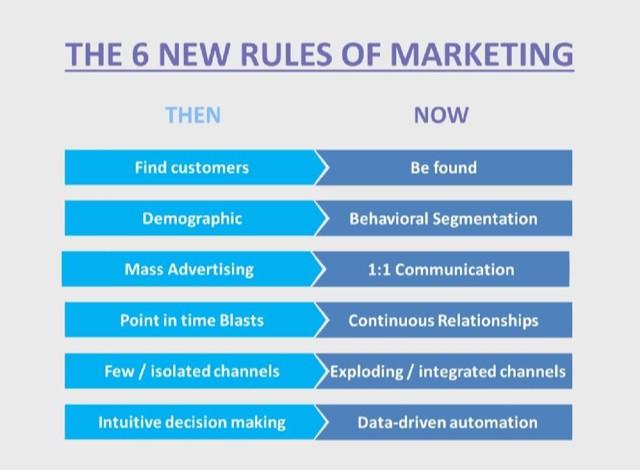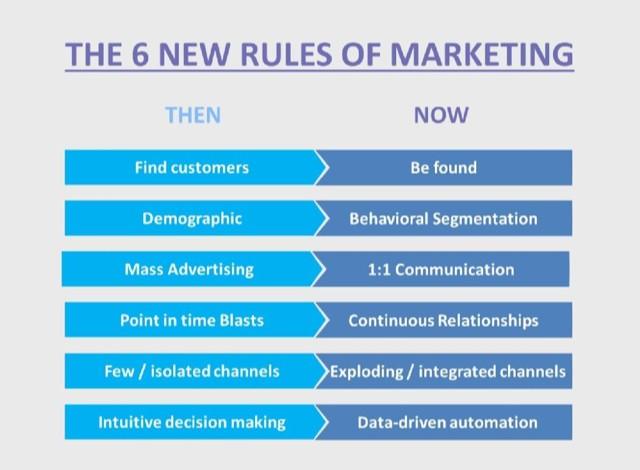The “New” Rules of Marketing for Accounting Professionals

Are you stuck wondering why marketing dollars are no longer working?
And while I would never dismiss a marketing campaign without testing, there are some fundamental differences in marketing today.
Thank you to Steve Pipe for posting this. Original poster TBD
So much of this poster sounds fantastic, but let’s break down what each rule means:
Finding Customers (old) vs Be Found
If there’s one rule that doesn’t seem dichotomous, it would be this. I recommend finding customers AND setting up systems to be found. Here are some tactical examples:
Finding Customers: Reaching out to event organizers, or networking group leaders, and offering to give a free seminar targeted to their community (artists, small businesses, etc)
Where does this fall short? In the ever growing skeptical world of prospecting, focusing 100% on outbound “finding customers” is a great example of “Working Harder, not Smarter”. Can you still find customers this way? Of course. Should you still use it? Yes, but be prepared to spend a lot of time using cold messaging to get in front of your customers. You can easily spend 40 hours a week cold emailing, only to get 1-2 new customers a month. This method should almost always be supplementing by “Being Found”
Being Found: This means prospects “bumping” into your company, by reading your blog, finding you in search results on Bing or Google (Via SEO or SEM), engaging with you on social media, and through word of mouth or referrals systems. As I love to say, prospects go into Research Mode before making any buying decision, and engaging, educating, and advising them during this stage is a perfect example of setting up opportunities for them “to find” your firm.
The goal is to “pull” new clients in, versus “pushing” your message into the marketplace.
Demographic (old) vs Behavioral Segmentation
In the past, it was easy to target a demographic and use that as your marketing “strategy”.
Well thanks to a countless number of new tools, it’s much more effective and cost efficient to segment and target your prospects through their behavior (which is a better indication of choice or preference).
Demographic example: Let’s target baby boomers in Pittsburgh, PA!
Behavioral Segments: Let’s target baby boomers who recently purchased Quicken or recently attended a Quickbooks course, and who had an average income of $50K /year. (Reason, perhaps you offer QB services, or want to go after a “techie” baby boomer. You only want ones of a certain income level because you found them the best fit for your service).
Another segmenting example: Let’s target all newly formed businesses within a 50 miles radius of our location, and invite them to our New Business Accounting Workshop.
Mass Advertising (old) vs 1-1 Communication
Can you imagine trying to do 1-1 communication and prospecting 20 years ago? It literally does not scale unless you have a massive budget for a sales team. Which is why mass “blanket” advertising (like Billboards) seemed like such a good bet. Well, unfortunately, people are not only Not Looking at Billboards, they’re reading their phones instead of driving! (this of course, is a different, albeit very important, concern).
In any case, with the added explosion of social media, prospects crave 1-1 communication. They fear the “faceless” company and love having 1-1, genuine relationships (in fact, this is how Zappos, a company which sold a complete commodity (shoes), was sold for $1,000,000,000 to Amazon. That’s a heck of a check).
Mass Advertising: Radio ads, billboards, “blanket” messaging over a market.
1-1 Communication: Receiving an email, and giving the prospect a call, or reaching out to them on LinkedIn. The point is, you have a 1-1, personalization experience, whether it’s during relationship building, sales prospecting, and (one would hope) during client servicing.
Point in Blast (old) vs Continuous Relationships
There was once a day when everyone dreamed of being *that* commercial during the Super Bowl. For a small fortune, you could get a 30-second “blast”, in hopes that this one message would somehow explode your business. Not anymore…
Point in Blast: Doing one “massive” marketing launch, in hopes that enough excitement pushed a flock of new clients into your firm.
Continuous Relationships: To be frank, I don’t believe “point in blast” was ever that effective, it’s just that they’ve become even less effective, so now they’re deemed “old”… but I digress. Look, your prospects will Go Into Research mode before making a decision. The good news is… you would do the same thing. Think about the last major purchase you made, whether it’s a car, house, or even the computer or smartphone you’re reading this on. You researched what to do. Well, prospects do the same thing, and the firm who educates, informs, and engages with the prospects during these phases (without being a pushy salesperson and acting more like a trusted advisor), will be better setup for success. Quick tactical example: Offering all new prospects a free guide called “7 Accounting Mistakes That Cripple Software Companies Profitability” (assuming Software Companies a niche you serve). This helps the prospect by educating them on how to think about their decision.
Isolated Channels (old) vs Integrated Channels
Very much in line with the previous point, “shoot in the dark”, isolated marketing means wasting massive amounts of money and effort. You must have integrated marketing channels and they must be ones where your prospects “live”.
Examples:
Isolated: “Let’s run a radio ad this week promoting our Fall Special… Then in 2 weeks, we’ll run a different promotion for a different service on Facebook!”
Integrated: Let’s run a tax readiness “boot camp” and send a letter to all previous customers who no longer use our service. After 5 days, anyone who doesn’t respond, we’ll give them a call to check in and see if they have any questions. Finally, on day 12, anyone who didn’t respond will get a final “email” reminder of the event.
Why do this? Your prospects are BUSY AND DISTRACTED … constantly. If they are not working, there are multi-billion-dollar companies competing against you for their attention. Therefore, a single, isolated message through a single channel will likely fall on few prospects. Most will ignore. But by using multiple step marketing campaigns across multiple channels, your 1% response rate can quickly go to 5, 6, even 7%.
Intuitive Marketing (old) vs Data Driven Marketing
To be honest, great marketers have always been data driven. In the past, it just took longer to get the data 🙂
For example, did you know when they sent out Sears catalogs, they would send small batches to “test cities” to see how they performed, and based on the results, use the better performing one and mail it nationwide?
I digress…
Intuitive Marketing: There was (and suppose, still is) a time where “big brand” style marketing was the dominant mindset in the field. Everyone was excited to “get their name out there” and “build the brand”. The danger with both of these “goals” is that you cannot measure them, and therefore can manage or even know how effective they were. This style of marketing leads burns through cash regardless of the ROI that it does (or doesn’t), bring in.
Data Driven Marketing: This is where you measure, measure, measure. Sure, you can still be creative. Still, run “wild” ideas if you want. But at the end of the day, it’s all about answering these questions…
1. Did it bring in a positive ROI? If yes, should we spend more?
2. If it didn’t bring in an ROI, how can we adjust or optimize the campaign to get to an ROI?
3. If it didn’t bring in an ROI, should we cut the campaign altogether?
You work hard to build your firm, and by focusing on the data, you protect your profit margins vs watching them disappear through “shotgun, hope-filled” marketing.
Final Thoughts
We’re not going to sit here and say all these ideas are completely “new”, and hyper effective marketers weren’t utilizing them ages ago. But the reason we posted that image is to illustrate some of the conscious (or even unconscious) beliefs we have on marketing. By reviewing this list, you’ll be better prepared to build an ROI-driven marketing campaign.






